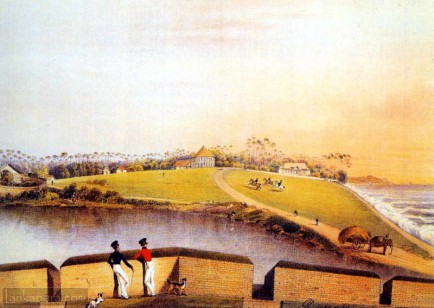
The galle-face esplanade from middleburg counterguard Capt.Charles Donatus Corbet O’Brien 1854
Artist: Giles, John West (fl. mid-19th century), after Deschamps, John (fl. 1845).
‘The Galle-face Esplanade, from Middleburg Counterguard.’ Plate 2 from ‘Scenery and reminiscences of Ceylon by I. Deschamps ESQ.’ London:1845.
This esplanade, or open space, on the side of the Fort towards Point de Galle (the high road to which runs through the centre of it), forms not only the principal exercising ground of the garrison, but also the general promenade of the inhabitants of Colombo and its vicinity, who repair thither morning and evening, on foot, on horseback, or in carriages, to inhale the delicious breeze which is almost always to be found by the sea-side of this part of the Island. Even in the calmest weather the surf comes rolling in, forming, as it were, a wall of foam, extending to Mount Lavinia, distant about seven miles; where, during the time of Sir Edward Barnes, a beautiful house, in the Italian style, was built as a marine residence for the governor, but which the spirit of economy in later years condemned to the hammer, the government-houses at Colombo and Kandy being considered sufficient.
Shortly before the author’s arrival, in 1828, a sad catastrophe occurred here, one morning, to a young man of the ordnance civil department, named May, lately landed, who, being tempted by the snowy and refreshing appearance of the surf to take a dip, was instantly seized at the thigh by one of the numerous sharks which infest the coast, and so dreadfully lacerated that, though immediately rescued by his companions, he expired from hemorrhage on the spot.
In the beginning of 1829, under the auspices of Sir Edward Barnes, horse-races were established here, and the ground being levelled, and the holes made by the land-crabs filled up – the latter operation requiring to be performed annually, or oftener – a good course of a mile and a quarter round was obtained, and the circular race-stand represented in the plate was built by subscription. It is a substantial building of brick, coated with a plaister of chunam, a preparation of shell and common lime; the roof, which is of conical shape, is covered with kejhans, made of cocoa-nut leaves – which form an excellent thatch-and projects over the verandahs on the ground and upper floors, from the latter of which a capital view of the whole course is obtained. The race-balls are held here, the upper room being cool and airy for dancing; card-tables are placed in the verandahs, whilst the lower portion forms a good supper-room.
A little way from the Fort, on the left, is the English burial-ground, enclosed by a strong fence of bamboos and an evergreen hedge, over which a sentry of the gun-lascars is placed. Here are several handsome monuments raised by affection and esteem to departed kindred and worth, the humble graves of soldiers and others being decorated with geraniums and various flowers, a practice now imitated in most European cemeteries. The Dutch burial-ground is at the entrance to the Pettah, on the opposite side of the Fort, whilst the remains of the native population repose in different localities, according to their religion. Text: http://www.bl.uk/
Image submitted by Niranjan Karunathilake